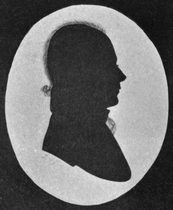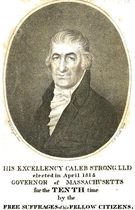William M. S. Doyle
Appearance

William Massey Stroud Doyle (1769-1828) was a portrait painter and museum proprietor in Boston, Massachusetts.
Portraits
He oversaw the Columbian Museum on Tremont Street in the early 19th century.[1][2]
As an artist, Doyle created portraits of:
|
According to historian Charlotte Moore, Doyle's daughter, Margaret Byron Doyle, "also worked as an artist."[13]
Gallery
-
Advertisement for Wm. M.S. Doyle, 1808
-
Silhouette portrait of Catholic priest John Cheverus, of the Holy Cross Church, Boston, 19th century
-
Portrait of a woman, 1810 (Smithsonian)
-
Portrait of Samuel Stockwell, 1810 (Museum of Fine Arts, Boston)
-
Portrait of Massachusetts governor Caleb Strong, 1814; drawn by Doyle, engraved by I.R. Smith
See also
- Columbian Museum, Boston (1795–1825)
References
- ^ Boston Directory. 1807, 1823
- ^ Boston medical and surgical journal, May 13, 1828
- ^ William Dunlap. A history of the rise and progress of the arts of design in the United States, Volume 3. Boston: C.E. Goodspeed & co., 1918. Google books
- ^ a b c d e f g Massachusetts Historical Society catalog. Retrieved 2010-09-02
- ^ Bolton. Wax portraits and silhouettes. Massachusetts Society of the Colonial Dames of America, 1915
- ^ a b c d e f g MFA collections. Retrieved 2010-09-01
- ^ Samuel Foster participated in the Boston Tea Party participant and fought in the American Revolution. cf. Bolton. 1915; p.45
- ^ Smithsonian
- ^ Harvard. Retrieved 2010-09-01
- ^ NYPL. Retrieved 2010-09-01
- ^ NYPL. Retrieved 2010-09-01
- ^ American Antiquarian Soc. Retrieved 2010-09-01
- ^ Encyclopedia of American folk art. 2004; p.139).
Further reading
- Alice Van Leer Carrick. Shades of our ancestors: American profiles and profilists. Boston: Little, Brown, and Company, 1928. Google books
- Arthur Kern and Sybil Kern. The pastel portraits of William M.S. Doyle. The Clarion (American Folk Art Museum), 1988; p. 41-47
- C. Moore. "William Massey Stroud Doyle." In: Gerard C. Wertkin, ed. Encyclopedia of American folk art. Taylor & Francis, 2004; p. 139.
External links
Wikimedia Commons has media related to William M. S. Doyle.
- Bostonian Society owns a "pastel self-portrait on paper of Doyle," April 22, 1828.
- Historic New England owns works by Doyle.




